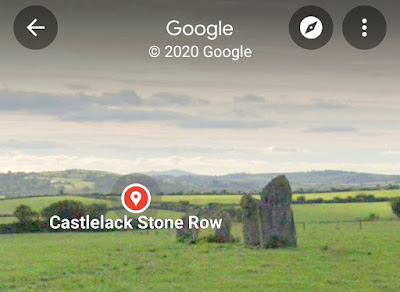Roman Amphitheatre of Uthina The Roman Amphitheatre of Uthina is located in Uthina , near Tunis, Tunisia . Building for Uthina began in 40 BC and continued through to 135 AD. The amphitheatre may have been a later addition to what was already a large town. Also located there were a fortress, cisterns, an aqueduct, a triumphal arch, a theatre, and a basilica with a circular crypt . Coordinates 36.608598,10.169214 Description The amphitheatre, partly buried, measures 113 by 90 meters. The arena measures 58 by 35 metres, giving surface areas of 7988 and 1539 square metres respectively. There are four entrances, two main entrances at each end, with the seating area supported by three tiers of columns and arches. (Although these are no longer there, measurements and amphitheater descriptions rely on a complete building.) Measurements for the amphitheatre on site are 12 0 by 89 metres, with the arena measuring 67 by 36 metres. The surface areas measure 10680 an d 24...
Castlelack Stone Row
Castlelack Stone Row or Castlenalacht Standing Stones are located by Castlenalact, Co. Cork, Ireland (or Castlelack).
There are four stones in a row with a further stone 246m further north, the four in a row increase in size towards the east.
Coordinates
51.798189,-8.745239
Stones
The stones are aligned at 30° towards the northeast, and the stones stand at heights of 3.4m, 2.7m, 1.9m, and 1.9m.
There are two further stones, one between the shorter stones but thought not to be original, and the other is 246m north as measured from one of the 1.9m stones and aligns north/south. The row is at an altitude of 143m, and the other stone further north is at 133m. Assuming the stones are 1m wide, then they are 2.5m apart.
Measuring from this north/south alignment, then one short stone and the 2.7m stone are 2.5m away and give an angle of 0.582°, an area of 307m² and 494m perimeter.
The other 3.4m tall stone is at an angle of 1.397°, an area of 738m² and perimeter of 498m.
If the perimeters in metres are used and converted to feet and subtracted from a megalithic mile measurement, then the following applies.
(A note that the measurement is converted to feet, but the megalithic mile is in metres).
Draconitic month
498×100=49800
49800÷30.48=1633.858
1633.858-1606.646=27.2122
Height/angle/perimeter
3.4-0.582°-494m
2.7-0-
1.9-0.582°-494m
1.9-1.397°-498m
Different months with durations and differences.
Draconitic 27.212220815 + 0.000000414 × T
Tropical 27.321582252 + 0.000000182 × T
Sidereal 27.321661554 + 0.000000217 × T
Anomalistic 27.554549886 − 0.000001007 × T
Synodic 29.530588861 + 0.000000252 × T
27.212220815
(0.109361437)
27.321582252
(0.000079302)
27.321661554
(0.232888332)
27.554549886
(1.976038975)
29.530588861
Conclusion
The difference in area varies from 0.03-0.7m from a Draconitic month to a Synodic month.
A mile (5280 ft) would vary the area from 498.82-499.52m, 0.82-1.52m more.
If the 264m and 494m perimeter is converted into feet and divided, 1.87 is produced.
1620.735÷866.142=1.87
There are two 494m perimeters and a 498m, which connects to the tallest furthest stone. The other stone is where the angles are measured from.
(The 498 equates to 1.89, which might be a short stone accurate height with 1.87m the other short stone).
The effect of the 30° is that a triangle of 30° by 2.5m has an area of 1.8m², which can then be added and subtracted from 494m, giving 495.8 and 492.2m.
(This is area with length).
This, though, is incorrect, and the increase/decrease should be added to 498m, giving 496.2 and 499.8m, with a mile equal to 1609.344m.
499.8×100=49950
49950÷30.48=1639.764
1639.764−1609.344=30.42
For a synodic month with 29.53 days, 499.5 is required, but 30.42 also equals a month as 365 divided by 12. The 496.2m perimeter gives a value of 18.6 or lunar standstill.
(The 494m gives a value of 14, but this is very near 13.66 and connected to a sidereal month).
The draconitic month is produced from 498m, and the 30° gives an equal 30.42 day month in 365 day year and a lunar standstill.
The stone further away and the two areas gives two different heights as there is a small difference in the two smaller stones, the accurate 1.5m increase to 499.5 gives a 29.53 day month which could be represented by the difference of the shorter stones and 1.5m hence giving an accurate height of 3.37m for the tallest.
The 2.7m stone could have an accurate height between 2.7212-2.7554m and hence represents a month.
So the Castlelack Stone Row could be described as representing various duration of months in days, by the perimeter of the area formed with it's alignment which also gives accurate heights for each stone. A possible date could be during the Iron Age.
The inclusion of the megalithic mile as the most accurate measurement shows that it was used but a much earlier monument showed that it faded in favour for the current measurement, a megalithic mile is also connected to a 30.42 day month. The most accurate measurement was for the draconitic month, which used the megalithic mile.
Lunar month
Archeology77 ©

Comments
Post a Comment